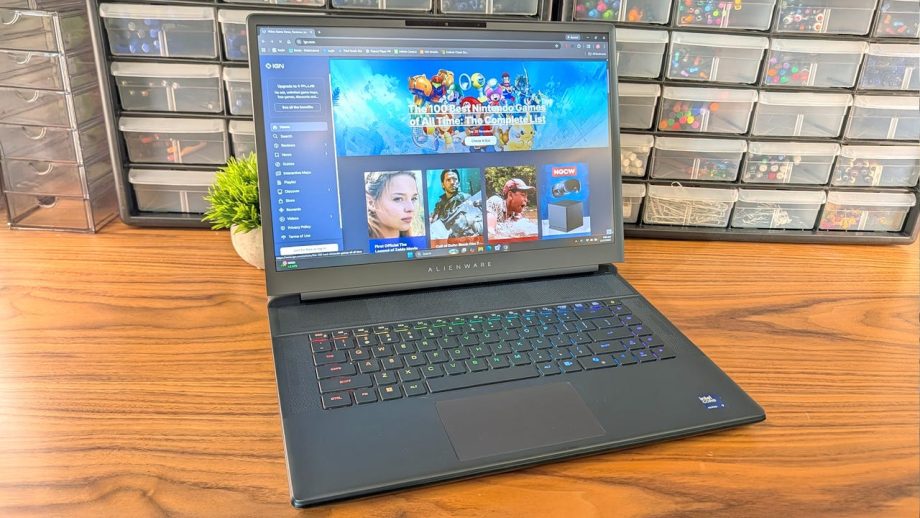The Alienware 16 Area 51 may just be the most unique gaming laptop I’ve reviewed this year. Its sci-fi-inspired styling immediately makes it stand out from the pack, but its great gaming performance and surprisingly heavy weight – nearly ten pounds with the power adapter included – make this more of a desktop replacement thana typical 16-inch gaming laptop. Its size and weight return with better cooling, high in-game FPS, and a luxurious user experience.
The Alienware 16 Area 51 embodies so much of what makes a great gaming laptop, it’s hard not to fall in love – with a couple exceptions. But if you can live with a few trade-offs, what you’re left with is a portable gaming rig that looks, feels, and plays every bit of its $3,000 price point.
Dell Alienware 16 Area 51 – Design and Features
Alienware’s designs aren’t always winners, but no one could accuse the brand of playing it safe. I’ve come to expect a healthy dose of science fiction from Alienware products after years of Alien-inspired designs. The last few years in the gaming laptop space have seen the brand strike a middle ground between uniqueness and general good looks, and the Area 51 is one of the best examples.
It’s available in a single colorway, a deep teal which makes up most of its lid. It’s not a common color for gaming laptops but looks beautiful in contrast to the black used throughout the rest of the case. It’s not a machine that will pass for a business laptop any time soon, unless business laptops start shipping with glowing alien heads on the lid and full RGB keyboard decks, but it’s not garish enough to be distracting if you turn off the lighting.
Review System Specifications
Display
16-inch, WQXGA (IPS), 500-nits
Resolution
2,560 x 1,600 (16:10)
Processor
Intel Core Ultra 9 275HX
Graphics
Nvidia GeForce RTX 5080
Ports
3 x USB Type-A 3.2 Gen 1, 2 x Thunderbolt 5, 1 x HDMI 2.1, 1 x SD Card slot, 1 x Audio combo Jack
Networking
Intel Killer Wi-Fi 7 BE1750 (2×2 320MHz) MIMO, Bluetooth 5.4
Audio
Woofer: 2W x 2 = 4W total, Tweeter: 2W x 2 = 4W total, Realtek Smart Amplifier ALC1708 (Woofer), RealTek amplifier ALC3329 (Tweeter), Dual-array microphones; Dolby Atmos; IntelliGo noise reduction
Dimensions (W x D x H)
14.37 x 11.41 x 0.85 – 1.12 inches
There are two less-common display upgrade options to choose from, and I recommend taking advantage of both. When you customize your own system, you can choose between a 4K and 1080p webcam and, surprisingly, there’s no price difference between them (though, presumably, the 4K camera will have a small impact on battery life, but I wasn’t able to test this to confirm). You can also choose between a standard or fully mechanical gaming keyboard with Cherry Ultra-Low Profile switches for an additional $50.
I was surprised to find that Dell didn’t outfit the system with an OLED display like the Razer Blade 16 and other close competitors around its price. Instead, it uses a 16-inch WQXGA IPS display with a 16:10 aspect ratio. Though it can’t deliver anywhere near the same black levels as an OLED, it looks very good and delivers a crisp picture thanks to its 2,560 x 1,600 resolution and esports-ready 240Hz refresh rate. It also doesn’t carry the same risk of burn-in or reduced performance over time and still offers great colors and 500-nits of peak brightness for use during the day.
The system is a chunker, though. On its own, it weighs in at 7.49 pounds and is 1.1 inches thick at its tallest point. If you actually plan on gaming and want the best performance, you’ll also need to lug around the bulky power brick, which adds another couple of pounds. Frankly, it’s not the kind of system I personally want to carry around every day. You feel every bit of its weight, even without the brick, which makes this system feel much more like a desktop replacement rather than something you’d actually carry with you throughout the day. But you can, so for the intermittent gaming marathon at a friend’s house or the campus library, it could still be a compelling option.
It comes with a generous port selection, so connecting peripherals or a docking station won’t be an issue. And I have to commend Alienware for making good use of its added thickness by putting most of that I/O around the back where it won’t get in the way of a mouse. There are three USB 3.2 Gen 1 Type-A ports, two Type-C Thunderbolt ports (version four for the RTX 5060 and RTX 5070 and Thunderbolt 5 for everything higher), and a full-size HDMI 2.1 video-out for connecting a monitor. Thunderbolt 5 is a major upgrade here, offering up to 80 Gbps of bi-directional bandwidth to support the highest resolution external monitors. The power brick also connects around the rear and uses a straight plug that doesn’t get in the way of other cables. The only other ports are on the left side. There, you’ll find an SD card reader and an audio combo jack.
The system also makes good use of its size for cooling. There are plenty of vents to bring cool air in and exhaust it out the back, away from your hands. The keyboard gets warm when gaming but doesn’t get hot or uncomfortable to use. The vent right above it does, but it’s away from your fingers. I recorded a peak temperature of 86°C after benchmarking for a good hour, which is well away from the range of thermal throttling. The system also didn’t get excessively loud, though like other high-performance gaming laptops, its fans are loud enough to warrant headphones if white noise bothers you – or you could just crank up the speakers.
The sound quality on the built-in speakers is surprisingly full-bodied compared to what you would usually expect from a gaming laptop. It uses dual two-watt speakers for bass, complete with their own amplifier that’s separate from its pair of two-watt tweeters. This isn’t common in gaming laptops, or even full-size gaming PCs, and allows the system to sound louder and more full as a result. Watching Netflix or listening to music with the included speakers is a no-brainer. For gaming, I would still opt for a gaming headset due to the loud fans.
My sample was sent with the Cherry mechanical keyboard, and it is 100-percent worth the cost to upgrade. Though it’s a little louder than a membrane keyboard, Cherry’s ultra low profile switches are sublime to type on with great tactility and the classic precision feel iconic to mechanical keyboards. They’re also per-key backlit and fully programmable, so you can change colors and assign macros to your heart’s content.
The trackpad also stands out by not being oversized like most other gaming laptops. It measures 4.5 by 2.5 inches, which I prefer to the massive trackpads on most gaming laptops. It may not offer as much real estate for gaming, but it stays out of the way for typing and, let’s be real, who uses a trackpad for serious gaming anyway? Like the keyboard, it’s also backlit and able to deliver a convincing RGB wave of its own.
The 4K webcam on my sample was also excellent. It handled challenging lighting well and its sharper quality was immediately noticeable. But since most teleconferencing apps still limit you to 1080p, whether it’s a real benefit over the FHD version will depend on how you plan to use it. There’s no privacy shutter, which is a bummer, but it does support Windows Hello and worked reliably for me throughout my testing.
There’s another interesting feature around the bottom of the system. Like the Razer Blade 18, Dell has added a window into the bottom panel giving you a peek into its internals. The pane is made of Gorilla Glass for durability and scratch resistance, and is surrounded by a protective lip, but I could still see this getting microscratches over time.
Dell Alienware 16 Area 51 – Software
The Alienware 16 comes with the Alienware Command Center for system configuration. It’s a very polished suite that’s designed to be easy to use, so newcomers don’t need to worry about being overwhelmed. At the same time, it offers more depth for advanced users that may want to try their hand at overclocking.
Opening it up for the first time, you’re given a brief introduction to its different capabilities and then dropped into the Command Center home page. This page provides you with a quick overview of system diagnostics like CPU and GPU utilization and temperature data. The same panel allows you to change your current performance mode, launch games, and, by clicking on the graphic of the laptop, customize the lighting of the keyboard, trackpad, and logo on the lid.
If you click into the Performance tab, you’ll be treated to a much larger view of the diagnostics from the home page. Along the top are six different modes: ExpressCharge for quicker charging, Quiet, Balanced, Performance, Overdrive, and Custom. Clicking a tooltip to the right shows details for each mode in both a star ranking and in text, so you know exactly how each balances performance, temperatures, and battery life.
The game launcher is a nice addition, but I personally never use systems like this. It essentially doubles up on Steam and other launchers. I could see launching a game from here if you had it open anyway, but otherwise, it just adds another piece of software running in the background.
Dell Alienware 16 Area 51 – Performance
The Alienware 16 Area 51 has a lot going for it in the design department, but that doesn’t amount to much if the laptop doesn’t hold its own when it comes to gaming. The system definitely does, and I suspect it has to do with its cooling system, but there’s more to the story than pure numbers.
Before getting into facts and figures, a quick reminder about our testing procedure at IGN. Every system we test is put through a series of synthetic and in-game benchmarks, all with the same settings and matching conditions, so we can provide the best comparisons possible. While the synthetic benchmarks we use are all standardized, in-game benchmarks offer many more options. To keep things consistent, we set all of our games to high or max settings and demonstrate the performance with different levels of upscaling and frame generation. Our settings are disclosed in the charts.
For this review, I’m presenting the Alienware 16 in comparison to the Gigabyte Aorus Master 16, which uses the same processor and graphics card. I’ve also included the Razer Blade 16, which utilizes the AMD Ryzen 9 AI HX 370 CPU and the higher performance RTX 5090, but in a thinner and more portable design.
The Alienware 16 Area 51 I reviewed is a high-performance configuration with a steep $3,000 price point to match, but you don’t need to spend that much if you’re willing to scale back on some of the components. Dropping to an Intel Core Ultra 5 255 HX and an RTX 5060 graphics card drops the price all the way to $1,849 when ordered direct from Dell.
To its credit, the company provides plenty of configuration options to help you dial in the system for your needs. In addition to the two processor options, you can choose any Nvidia laptop GPU up to the RTX 5090, and choosing anything from the RTX 5070 Ti up also nets you the higher performance CPU. It can be configured with up to 64GB of memory and 12TB of NVMe storage, both of which are user upgradeable.
Beginning with synthetics, the Alienware 16 comes out swinging, eking out higher scores across the board compared to the Aorus Master 16. Every score is close, as you would expect from a system with the same core components, but the consistently higher performance definitely points to a better implementation from Dell. The Blade 16 bests both in 3DMark’s Speed Way and Steel Nomad benchmarks thanks to its higher-performance RTX 5090. The results of the Procyon Office Productivity benchmark highlight the advantage the Intel Core Ultra 9 275 HX offers over the AMD Ryzen 9 AI HX 370.
The Alienware’s performance advantage remains consistent when we move to in-game benchmarks. Performance remains expectedly close between it and the Aorus Master 16, but it still pulls the same or slightly better performance across everything but Assassin’s Creed Shadows with frame generation disabled. The difference is small enough to not be noticeable and potentially a result of a process spinning up in the background.
At the laptop’s native 1600p resolution, the trend continues. With the exception of Assassin’s Creed, the Alienware 16 pulls a consistent, if small, lead over the Aorus and both of them match or beat the Razer Blade 16 more often than you might expect.
The Alienware 16’s cooling system may be the cause, as the Aorus Master reached a peak of 93 degrees Celsius in my testing. It could also be how Dell has configured power delivery for the laptop. Either way, it offers impressive performance even in demanding games.
When it comes to use as a daily driver, it’s mostly excellent. The keyboard is the best I’ve ever used on a gaming laptop, even topping the MSI Titan 18 HX AI which also has a Cherry ULP mechanical keyboard. The trackpad has also been one of my favorites. I prefer a smaller trackpad in general, but the accuracy and reliability it offered were fantastic. This is one of the only laptops I’ve tested where I didn’t misclick or activate it by accident even once, despite cranking out thousands of words in the time I’ve had it.
The biggest issue facing it is how heavy it is and just how much it needs its power brick. Gaming performance takes a big hit the minute it’s unplugged and battery life plummets. This goes with the territory for gaming laptops, of course, but most others with this size display aren’t tipping the scales as heavily as the Alienware 16. The Aorus Master 16, for comparison, is almost two pounds lighter while offering similar performance and a nicer OLED screen. Battery life tanks when it’s unplugged too, of course, but at least it’s easier to carry with the power brick.
For pure productivity, it works well and you’ll be able to get a few hours out of it for mixed use. But, in that case, you can also take advantage of its Thunderbolt ports and charge it with a much smaller 100W GaN charger. Just be warned, it’s not enough to overcome the power draw when you’re gaming, or to unlock its full performance, so it’s a solution that only works some of the time.
When it comes to battery life, the Alienware 16 was able to last just over six hours in Procyon’s battery life test with the screen set to half brightness. I personally find this is a bit too dim for my own use, even indoors, but that comes down to preference. At that brightness and with mixed use between Google Docs, Sheets, web browsing, and Microsoft Office, it lasted closer to four hours with Energy Saver mode turned on.
Christopher Coke has been a regular contributor to IGN since 2019 and has been covering games and technology since 2013. He has covered tech ranging from gaming controllers to graphics cards, gaming chairs and gaming monitors, headphones, IEMs, and more for sites such as MMORPG.com, Tom’s Hardware, Popular Science, USA Today’s Reviewed, and Popular Mechanics. Find Chris on Twitter @gamebynight.






